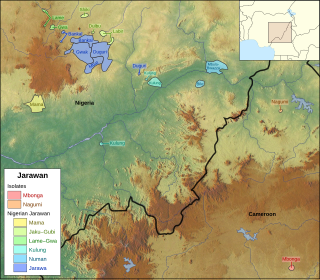The Adamawa–Ubangi languages are a geographic grouping and formerly postulated family of languages spoken in Nigeria, Chad, the Central African Republic, Cameroon, Gabon, the Republic of the Congo, the Democratic Republic of the Congo and South Sudan, by a total of about 12 million people.
Jalaa, also known as Cèntûm, Centúúm or Cen Tuum, is an extinct language of northeastern Nigeria, of uncertain origins, apparently a language isolate. The Jalabe speak the Bwilim dialect of the Dikaka language. It is possible that some remembered words have been retained for religious ceremonies, but in 1992 only a few elders remember words that their parents had used, and by 2010 there may not even remain any such rememberers.
An unclassified language is a language whose genetic affiliation to other languages has not been established. Languages can be unclassified for a variety of reasons, mostly due to a lack of reliable data but sometimes due to the confounding influence of language contact, if different layers of its vocabulary or morphology point in different directions and it is not clear which represents the ancestral form of the language. Some poorly known extinct languages, such as Gutian and Cacán, are simply unclassifiable, and it is unlikely the situation will ever change.
The Adamawa languages are a putative family of 80–90 languages scattered across the Adamawa Plateau in central Africa, in Nigeria, Cameroon, Central African Republic, and Chad, spoken altogether by only one and a half million people. Joseph Greenberg classified them as one branch of the Adamawa–Ubangi family of Niger–Congo languages. They are among the least studied languages in Africa, and include many endangered languages; by far the largest is Mumuye, with 400,000 speakers. A couple of unclassified languages—notably Laal and Jalaa—are found along the fringes of the Adamawa area.
The Savannas languages, also known as Gur–Adamawa or Adamawa–Gur, is a branch of the Niger–Congo languages that includes Greenberg's Gur and Adamawa–Ubangui families.
Lunguda (Nʋngʋra) is a Niger–Congo language of Nigeria. They settle western part of Gongola mainly in and around the hills of the volcanic Lunguda Plateau, Adamawa state. Joseph Greenberg counted it as a distinct branch, G10, of the Adamawa family. When Blench (2008) broke up Adamawa, Lunguda was made a branch of the Bambukic languages.
The Tula–Waja, or Tula–Wiyaa languages are a branch of the provisional Savanna languages, closest to Kam (Nyingwom), spoken in northeastern Nigeria. They are spoken primarily in southeastern Gombe State and other neighbouring states.
The Duru languages are a group of Savanna languages spoken in northern Cameroon and eastern Nigeria. They were labeled "G4" in Joseph Greenberg's Adamawa language-family proposal.

Jarawan is a group of languages spoken mostly in Bauchi State, Nigeria, with some also scattered in Plateau State, Taraba State, and Adamawa State in the same country. Two related languages formerly spoken in Cameroon are now extinct but are believed to have belonged to the group. This connection between Nigerian and Cameroonian Jarawan is attributed to Thomas (1925). Whether Jarawan languages are best classified alongside other Bantu languages or among non-Bantu Bantoid languages is a matter of ongoing debate. A number of descriptions and classifications in the early 20th century suggest that they be may historically related to Bantu languages but not necessarily Bantu themselves. Other perspectives based on lexicostatistic modeling and other phylogenetic techniques for language comparison argue instead that Jarawan languages are properly classified alongside Zone A Bantu languages (A31-A40-A60). For classifications based on these more recent studies, see for example Blench (2006), Piron (1997), and Grollemund (2012).
The Gwèri or Vere language Were also known as Kobo or Mom Jango, is a member of the Duru branch of Savanna languages. It is spoken across the northern Nigerian–Cameroonian border.
Waja is a Savannas language of eastern Nigeria. Dialectical differences between Deruwo and Waja proper are slight.
Tula is one of the Savanna languages of Gombe State, northeastern Nigeria.
Dadiya is one of the Savanna languages of northeastern Nigeria. They are found in Gombe, Adamawa & Taraba state. The Dadiya people of Gombe State are found in Balanga local government, while those in Adamawa and Taraba are found spread in Lamurde and Karim-Lamido Local government area respectively.
Tso is one of the Savanna languages of eastern Nigeria.
Dikaka or Cham, is one of the Savanna languages of Middle Belt, Nigeria. It is also known as Dijim–Bwilim, after its two dialects, Dijim and Bwilim. A tonal language, it has a whistled register. It is spoken in Gombe and southwestern parts of Adamawa State of Nigeria.
Kamo is a Savannas language of Gombe State, eastern Nigeria. Their original settlement was on Kamo Hill, but it was abandoned as the speakers gradually moved down into the plains during the 20th century.
Yebu is one of the Savanna languages of Kaltungo LGA in Gombe State, northeastern Nigeria.
Bangwinji (Bangjinge) is one of the Savanna languages of Gombe State, eastern Nigeria. Their ethnonym is Báŋjìŋèb.
Duli is an extinct Adamawa language of northern Cameroon.
The Bena–Mboi (Ɓəna–Mboi) a.k.a.Yungur languages form a branch of the Adamawa family. They are spoken in central Adamawa State, eastern Nigeria, just to the east of Lafia LGA.